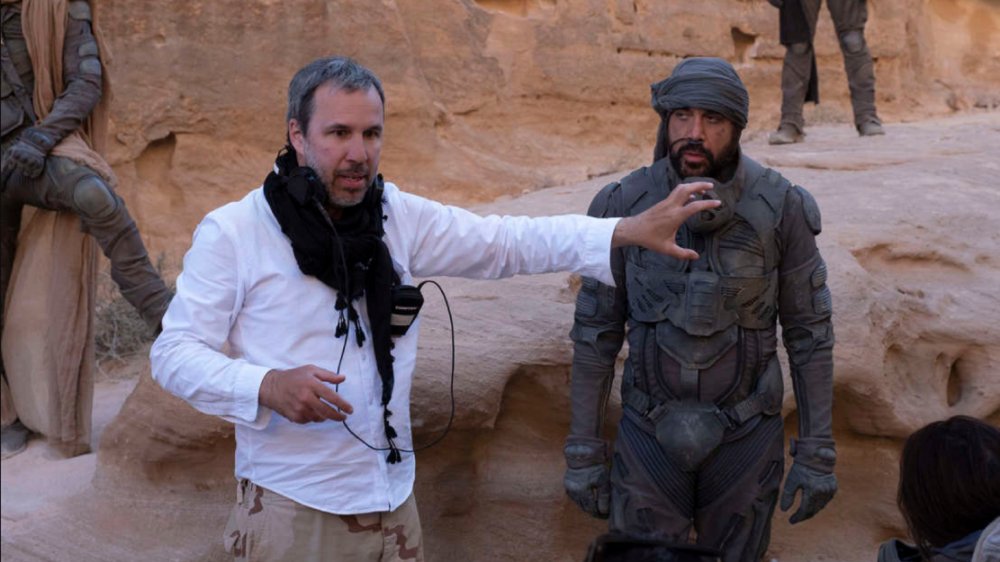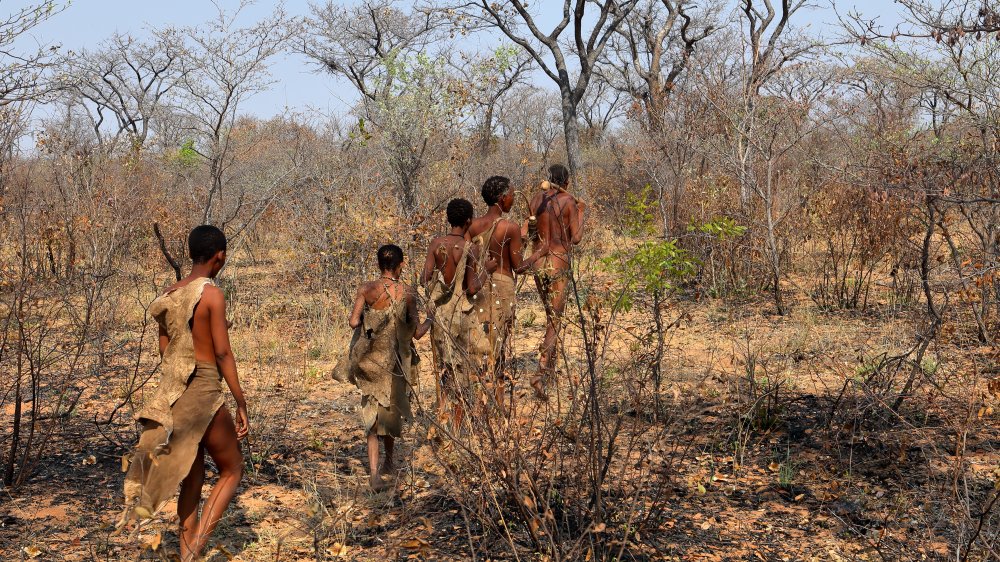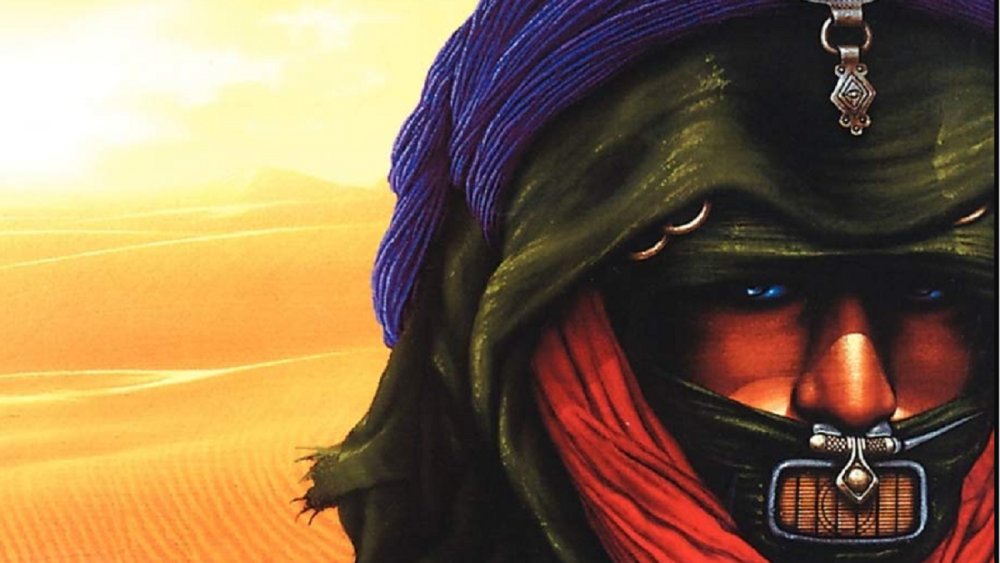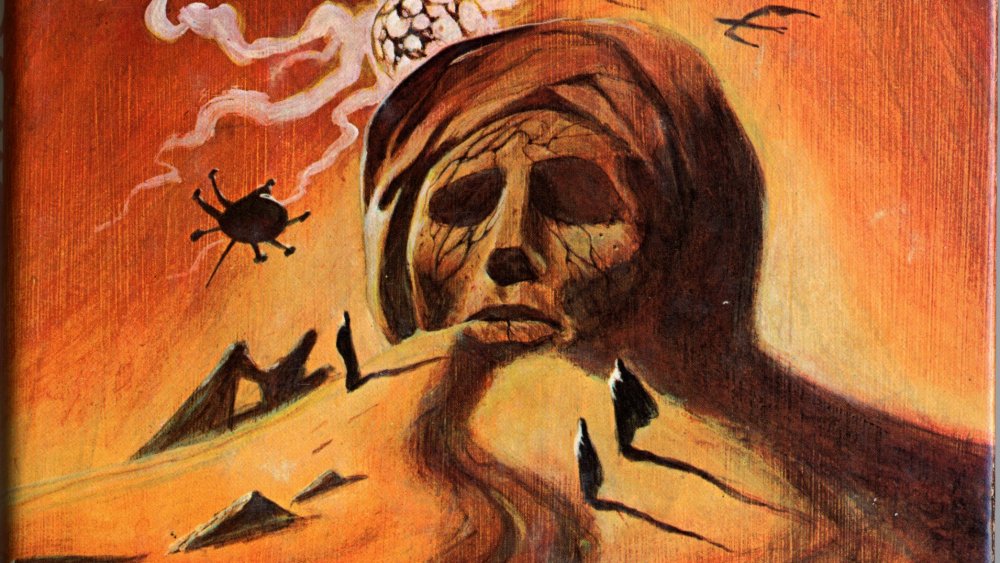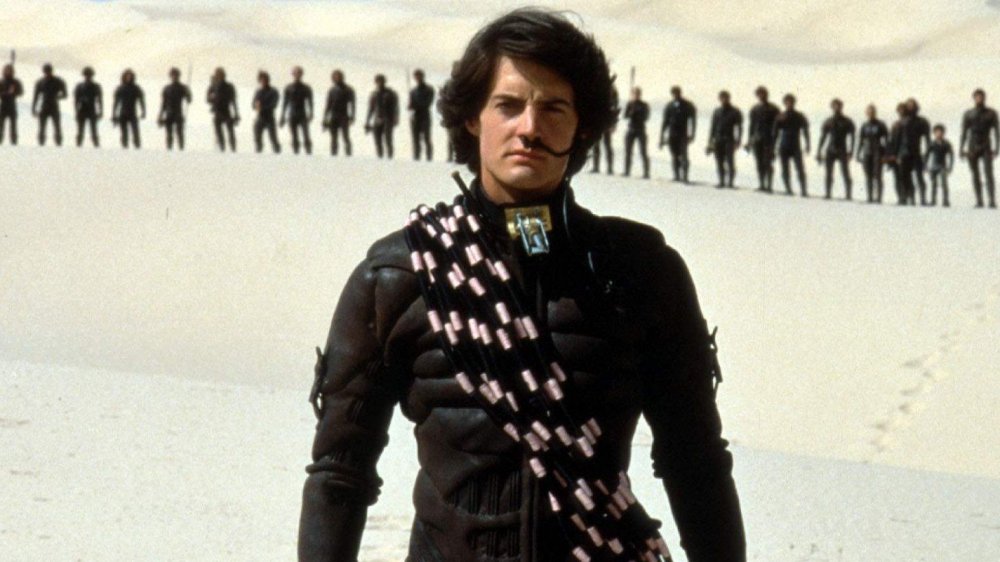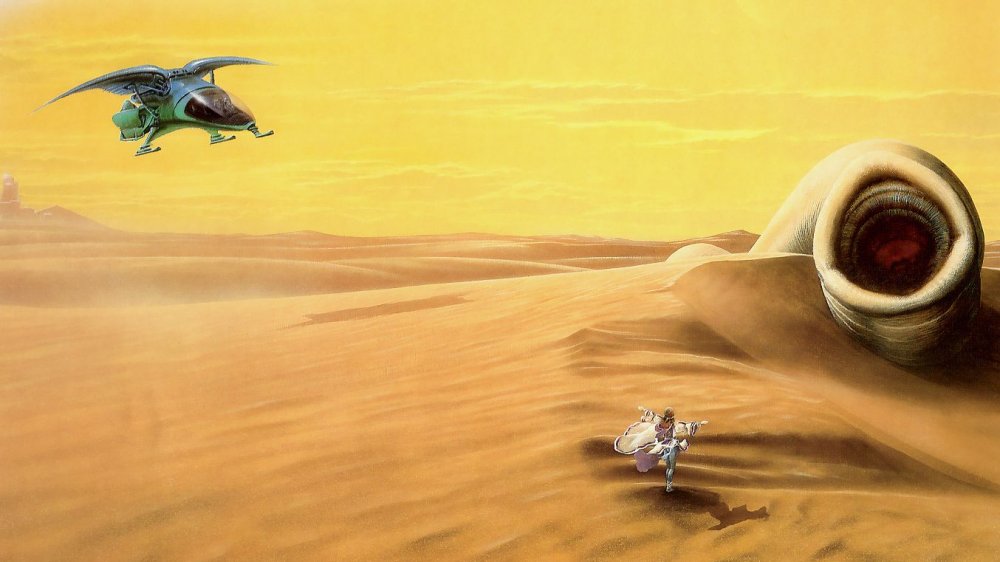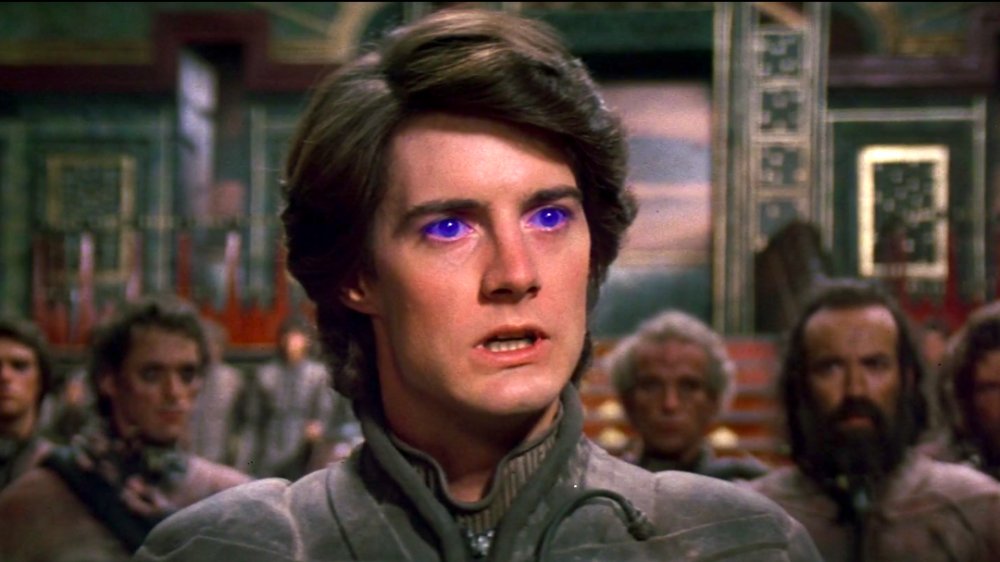The Backstory Of Dune's Fremen Explained
Though you wouldn't know it from the frenzy surrounding its first trailer, Dune is a deeply unlikely candidate for a blockbuster movie. The story grapples with themes of humans trying to shape a planet's ecology, the dangers of mining natural resources, and the problems inherent to political idolatry. It's a far more complicated portrait of a space opera than just about anything Hollywood's ever successfully put forward.
At its heart, Dune is the story of a planet's native people rising up to stop the continued mining and reshaping of that planet by neo-colonial offworlders from a galactic imperium. It pits the Fremen, a group of desert-dwelling nomads who have learned how to live in relative harmony with the harsh, titular planet of Arrakis (colloquially known as Dune) against the Padishah Emperor on the distant planet of Kaitain, the head of a government that needs to exploit Dune's sole resource to ensure the continued growth of the galactic economy. Yes, this is the level of allegory we're dealing with here.
Frank Herbert's Dune series comprises six novels, beginning with Dune and ending with Chapterhouse: Dune, a novel millennia removed from the archetypal characters that populate the original book. Dune's protagonist Paul Atreides grows into a god-like figure over the course of the first book by joining the Fremen, who raise him to messianic status as their prophesied "Mahdi." To access this story, you have to empathize with the Fremen, a people who live a life far removed (geographically, chronologically, and otherwise) from the imperial culture from which Paul Atreides hails. The Fremen serve as both the Dune series' heart and its narrative backbone. This is their story.
Real-world inspiration
Herbert didn't create this desert culture out of whole cloth. He drew inspiration from a healthy mix of world religions and several actual indigenous cultures on Earth. In particular, he looked at the way that these peoples managed to make a life for themselves in places that might be considered inhospitable (particularly from a European perspective). Herbert was compelled to write Dune after hearing of a project by the United States Department of Agriculture that would make Oregon's marching sand dunes static. The USDA planted poverty grasses along the dunes to keep them from steadily moving, as the sand could wreak havoc on nearby roadways and towns.
Herbert was in awe of the way that the sand could "swallow whole cities" and decided to contrast the governmental response of changing the landscape with the way that native people across the Earth learned to live in harmony with the natural processes. The Empire of Dune and its representative feudal houses came to represent these outsiders reshaping worlds in ways that make them more profitable, while the Fremen stood in for the ideas of harmonious living. Herbert based the Fremen in large part on the San people who live in the Kalahari desert. Like the Fremen, the San learned to conserve water in order to survive in some of the most unforgiving terrain on Earth.
Origins
In the books, the Fremen are descendants of a persecuted religious group that fled across the void of space to evade imperial violence. The Zensunni Wanderers, nomadic believers in a religion that combined tenets of Sunni Islam and Herbert's own belief in Zen Buddhism, traveled from planet to planet to find a place outside the reach of the Imperium.
Their final stop was Arrakis, a barren desert planet believed to be worthless before the discovery of a spice called melange. Melange gave all who consumed it a minor amount of prescience, and quickly became crucial for navigating ships in a galaxy that had created faster-than-light travel. The Fremen found themselves in a familiar situation to anyone who knows about the Amazon rainforest or the so-called American frontier. They were the people living on top of a coveted natural resource, and they suffered in similar ways to their analogues on Earth.
Examples of human ingenuity
While the Fremen were viewed as backwards and savage by Dune-colonizing outsiders, their culture was an incredible example of the ways in which humanity can survive in the least probable situations. Because of the extreme scarcity of water on the surface of their planet, a huge chunk of Fremen culture and ritual is based around the collection and conservation of this vital mineral. They travel the surface of Dune dressed in stillsuits, full body coverings that collect and filter sweat, respiratory droplets, and waste, and store it in catch-pockets. This water is then recycled via tubes that are pumped through levers in the stillsuit's heels. In this perfectly closed system, not a drop of water is wasted.
The Fremen conception of wealth revolves around the collection of water, as well. They live in small bands that move between underground "sietches," where they store their water communally. Individuals wear jewelry that symbolize their share of the water. When Fremen die, their bodies are rendered in a holy ceremony, and their water is added back to the wealth of the tribe.
The Fremen have also managed a cautious coexistence with the desert's greatest threat: sandworms. Called "makers" by the Fremen, the massive creatures tunnel through the desert sand and appear at the slightest noise. Fremen learn at a young age how to walk through the desert in a sliding, arrhythmic gait that mimics the natural settling of sand to avoid drawing sandworm attention — unless they're looking to hitch a ride. That's right: The Fremen also have a strategy for riding the sandworms of Dune, a dangerous maneuver that — when successfully performed — allows them to cover massive stretches of the desert at a clip, This technique is a closely guarded secret of their community.
A hidden civilization
The trick of sandworm riding isn't the only secret of the Fremen. Though the Empire believes that they are few in number, the truth is that a massive society has blended into the desert, where they lie in wait at the beginning of Dune, safe from prying eyes. From the safety of their underground sietches, the collected Fremen have been working on a generational terraforming project that will eventually transform Dune into a verdant and hospitable planet.
In a miscalculation that will ultimately prove to be fatal for the Emperor, his government assumes that there are very few Fremen living in the expansive global desert that covers Dune's surface. This secret society of desert nomads, wise in the ways of the desert, provides an army lying in wait for Paul Atreides (who assumes the Fremen name Muad'dib) to invade the polar port city of Arrakeen.
The spark
If it wasn't already obvious, the Fremen play a major role in the plot of Herbert's first Dune novel. When the family of the latest imperial governor on Dune is overthrown by a scheming family looking to settle a blood feud, the son of that governor escapes to the desert with his mother, the Lady Jessica. Jessica takes advantage of prophecies that had been seeded among the Fremen by a holy order known as the Bene Gesserit to which she belongs. Using this "Missionaria Protectiva," she coerces the Fremen into accepting her son as their messiah. His name is Paul Atreides, but he quickly assumes a Fremen name meaning "kangaroo mouse," a creature that the Fremen admire for its ability to live on the surface of Dune. Fun fact: In the real world, mu'addib is Arabic for teacher, more evidence that Herbert was deeply inspired by Arabic and Islamic culture.
It's Paul's reciprocal embrace of Fremen traditions that leads him to the spice and the awakening of his dormant powers of prescience. Without the Fremen, Paul and Jessica might never have survived their exile to the desert, and they certainly wouldn't have been able to mount an assault on Harkonnen Arrakeen.
Taking Dune
All this talk of the Missionaria Protectiva suggests that Jessica somehow tricked the Fremen into accepting Paul, but that's not exactly the case. He became a true messianic figure during his time among the Fremen. The boy had been trained by his mother in the weird arts of observation, control, and perception practiced by the Bene Gesserit witches for generations. This typically all-woman mystical order exerts influence by subtly molding the genealogy of Great Houses and inserting their converts into bloodlines in the hopes of creating their own messiah known as the Kwisatz Haderach. This figure would be able to access areas of prescience that the Bene Gesserit witches could not reach, places believed to be unattainable by women as they reside along the patrilineal bloodline.
In short, generations of witches had worked to eventually create a son who would be trained in their ways. Though Paul's mother had not been given the go-ahead to train Paul (and her son was not expected to become the Kwisatz Haderach), she trained Paul anyway knowing that he would be killed by the forces allied against their family if he was not prescient. When these powers combined with Paul's training as a Fremen, he became a mystic desert dweller who could see the future and use it to reshape Dune.
Using an army of Fremen who heard his revolutionary message, and armed with the knowledge of how to destroy the precious spice that facilitates all space travel, Paul simultaneously attacks the Empire's outposts, while holding the galaxy's spice supply hostage. The Emperor is forced to cave to Paul Muad'Dib, who becomes the undisputed ruler of Dune.
Cosmic jihad
Even though Paul is the ruler of Dune, revered as a god in the flesh by the Fremen he'd freed from imperial rule, history quickly slips out of his control. The reverence and religious fervor surrounding Muad'Dib (as well as the need to crush dissenters who might try to reclaim Dune) transmogrifies into a cosmic jihad waged in Paul's name, fought and led almost entirely by his army of Fremen fedaykin warriors with the imprimatur of his religious order, the Qizarate.
Hundreds of worlds and billions of people come under the sway of Paul's empire in the early days of his reign. A religion grows around him and the Fremen homeworld of Dune becomes a kind of space-age Jerusalem. Paul's prescience shows him where this path is headed. Hemmed in by his future visions and his status as the godhead, Paul is essentially paralyzed to act in any way that might assure his people's enduring salvation.
Old ways in a modern world
Among the Fremen, there is an undercurrent of dissent from older veterans of Paul's wars who don't like the way that Fremen culture is changing. As Paul makes water more available and plentiful, older Fremen look on in horror as the strict codes observed by previous generations begin to disappear. In addition to that, the fedaykin become disillusioned with the war effort when they come home to meager pensions and comfortable suburban homes that carry little trace of the harsh life of the sietch.
A plot is hatched among these Fremen dissenters to assassinate Paul. These rebels are egged on by the Spacing Guild who have lost their unfettered access to the spice melange and Bene Gesserit witches who have lost control over their breeding program. Paul sees these machinations in his visions, but has trouble figuring out how to avoid these plots bearing fruit without causing more misery.
Ultimately, he allows himself to be grievously wounded by the Fremen dissenters. He is blinded by a nuclear blast near the holy city — an attack that he foresaw. The strict Fremen way of life holds that anyone who loses their sight must wander out into the desert and allow himself to die, rather than slowing down the tribe. Though Paul is an emperor and could have carried on without his sight, he sees in this path a way off the treadmill carrying him toward the Fremen's ultimate demise. In sacrificing himself pursuant to traditional Fremen law, he silences the doubts of the traditionalist hardliners who worried that he had forgotten the ways of the Fremen.
The end of all Fremen
Under the 3,500-year reign of Paul's son Leto II, the Fremen culture grows faint. By merging with sand trout, a kind of larval stage of the great sandworms of Dune, Leto II becomes a nearly immortal human-sandworm hybrid who reigns long enough to realize the great dream of Liet-Kynes to terraform Dune into a moist, temperate planet. He succeeds in this mission, but destroys the Fremen culture in the process. The last of the Fremen who wish to hold to the old ways are consigned to a living museum, a pseudo-sietch called "the sareer" where they live as their ancestors did.
Leto is ultimately killed by one of his descendants, a Fremen-Atreides named Siona who has evolved the ability to hide from his power of foresight. Siona's assassination of Leto sets off the "Great Scattering," an event that sees the many peoples of the former empire dispersed in a galactic diaspora. Without access to the spice, they are essentially isolated for thousands of years on their planetary islands.
When the peoples of the Scattering return, one particularly violent sect — The Honored Matres — bombards the surface of Dune with planet-destroying weapons called Obliterators, killing the last remnants of the Fremen civilization. In Frank Herbert's original series of six novels, only one Fremen escapes the scouring of Dune: a girl named Sheeana, a name derived from the original Fremen "Siona," and a mainline descendant of Paul Atreides.
